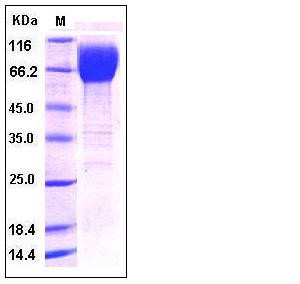Human CD80 / B7-1 Protein (His & Fc Tag)
B7,B7-1,B7.1,BB1,CD28LG,CD28LG1,LAB7
- 100ug (NPP1182) Please inquiry
| Catalog Number | P10698-H03H |
|---|---|
| Organism Species | Human |
| Host | Human Cells |
| Synonyms | B7,B7-1,B7.1,BB1,CD28LG,CD28LG1,LAB7 |
| Molecular Weight | The recombinant human B7-1/Fc is a disulfide-linked homodimeric protein. The reduced monomer consists of 455 amino acids and predicts a molecular mass of 51.7 kDa. By SDS-PAGE, the apparent molecular mass of rh B7-1/Fc is approximately 80-90 kDa due to the glycosylation. |
| predicted N | Val 35 |
| SDS-PAGE |  |
| Purity | > 95 % as determined by SDS-PAGE |
| Protein Construction | A DNA sequence encoding the extracellular domain (Met 1-Asn 242) of human B7-1 (NP_005182.1) precursor was fused with the C-terminal His-tagged Fc region of human IgG1 at the C-terminus. |
| Bio-activity | 1. Measured by its ability to bind human CD28 in a functional ELISA. 2. Measured by its ability to induce IL2 secretion by Jurkat human acute T cell leukemia cells. The ED50 for this effect is 0.2-0.5μg/mL |
| Research Area | Developmental Biology |Embryogenesis |Germ Layer Formation |Ectoderm Marker |
| Formulation | Lyophilized from sterile PBS, pH 7.4 1. Normally 5 % - 8 % trehalose and mannitol are added as protectants before lyophilization. Specific concentrations are included in the hardcopy of COA. |
| Background | The B-lymphocyte activation antigen B7-1 (referred to as B7), also known as CD80, is a member of cell surface immunoglobulin superfamily and is expressed on the surface of antigen-presenting cells including activated B cells, macrophages and dendritic cells. As costimulatory ligands, B7-1 which exists predominantly as dimer and the related protein B7-2, interact with the costimulatory receptors CD28 and cytotoxic T lymphocyte-associated antigen 4 (CTLA-4) expressed on T cells, and thus constitute one of the dominant pathways that regulate T cell activation and tolerance, cytokine production, and the generation of CTL. The B7/CD28/CTLA4 pathway has the ability to both positively and negatively regulate immune responses. CD80 is thus regarded as promising therapeutic targets for autoimmune diseases and various carcinomas. |
| Reference |
